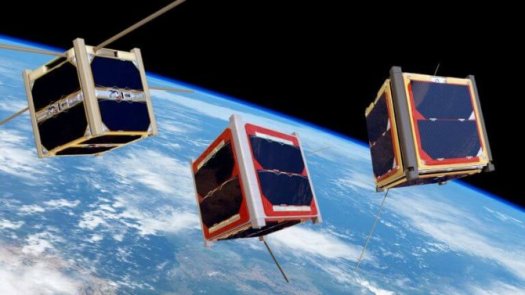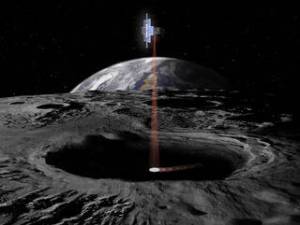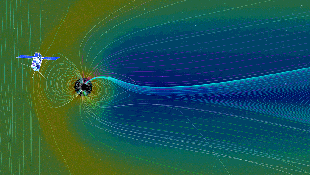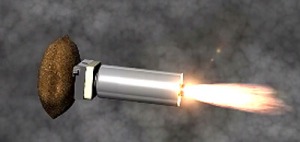
CubeSats are the anti-big ticket space missions.
They come as small as 4 inches squared and in units that size weigh about 3 pounds. They currently carry cameras, high gain antennas, radios and other scientific equipment, and because of their weight and size they can easily hitch a ride on a rocket sending a traditional large payload into orbit.
More than 900 CubeSats have been launched since they began in being deployed early this century, but only two have left low-Earth orbit.
Those two went to Mars last year along with the InSight lander (a deep geology mission) and despite some short-term but nerve-racking radio silence just before they were needed, they performed exactly as planned.
In the process they both heightened the profile and the desirability of CubeSats as a growing addition to space science and commerce.

Called Mars Cube One or MarCO, the two that accompanied InSight were both a technological demonstration and an important operational component — serving as the communication link between the spacecraft and Earth for seven crucial minutes during InSight’s descent.
“We exceeded expectations,” said MarCO chief engineer Andrew Klesh of NASA’s Jet Propulsion Lab, speaking during a NASA Future In-Space Operations (FISO) webinar.
“Getting into deep space like we did shows that this is only the beginning for CubeSat missions to explore the solar system. They are a real addition to communications and they provide a new way to conduct science along the way.”
While they were launched on the rocket that sent InSight to Mars, they detached soon after liftoff and flew on their own power to the scheduled meeting place on Mars.
The MarCO CubeSats maintained contact with Earth for almost all of the 6 month journey to Mars and then performed as planned during the InSight descent and landing, they lost touch with Earth only weeks after. They will, however, continue traveling on an orbit around the sun.

The advantages of the CubeSats are pretty straight-forward. They cost much, much less than a larger spacecraft, they take a much shorter time to develop and ready for flight, and they can be operated with much smaller teams — many of them made up of young scientists. MarCo, for instance, cost $18.5 million, was put together in 16 months and was put together and operated by a crew of 15, only one of them dedicated full-time.
They are also a kind of gateway technology for those looking to get involved in space exploration. Nations including Colombia, Poland, Estonia, Hungary, Romania and Pakistan have begun their own space programs by hitching a ride with a CubeSat.
NASA’s CubeSat Launch Initiative (CSLI) has been supporting the technology since 2010, and focusing on enabling CubeSat technology to spread to many American colleges, universities and organizations where they can usually be built with commercially available technologies and products. The MarCO CubeSats, however, were developed and built at the Jet Propulsion Lab.
CubeSats, of course, also do much less than larger missions and are unlikely to make the kind of major discoveries the traditional NASA ventures make possible. But that could change in the future and their sheer numbers — scientists talk of future “swarms” of CubeSats — could make them increasingly valuable.
CubeSats are a class of nanosatellites that use a standard size and form. The basic CubeSat size uses that four-inch squared “one unit” or “1U” and is extendable to larger sizes; 1.5, 2, 3, 6, and even 12U. MarCO’s design was a six-unit CubeSat, about the size of a briefcase.
They were originally developed in 1999 by engineers and scientists at California Polytechnic State University at San Luis Obispo and Stanford University.

Even before the MarCO success, NASA had scheduled thirteen CubeSats to be launched on the first Space Launch System (SLS) heavy rocket, scheduled to go up in the summer of 2020. That mission will be to the moon and so most of the CubeSats will also stay in the environs.
Unlike MarCO, which had a primary mission of relaying data during descent and landing, these thirteen will be focused on science and exploration. Their missions range from carrying living yeast to monitor the effects of radiation on it over many months, to searching for deposits of frozen water on the moon, to proof-of-concept testing of a solar sail spacecraft that would be sent to a near-Earth asteroid.
Here is the line-up for that often-delayed and much-anticipated flight:
- Lunar Flashlight is a spacecraft that will seek exposed water ice, and map its concentration at the 1-2 kilometer scale within the permanently shadowed regions of the lunar south pole.

- Near-Earth Asteroid Scout is proof-of-concept of a controllable CubeSat solar sail spacecraft capable of encountering near-Earth asteroids. The satellite will fly about 7 miles away from an asteroid and will use a high resolution camera to measure the physical properties of a near-Earth asteroid. The potential targets will be determined based on launch date, time of flight, and rendezvous velocity.

NEA Scout will perform reconnaissance of an asteroid, taking pictures and observing its position in space. - BioSentinel is an astrobiology mission that will use yeast to detect, measure, and compare the impact of deep space radiation on living organisms over long durations beyond low-Earth orbit.
- SkyFire is a spacecraft designed by Lockheed Martin to fly by the moon and collect surface spectroscopy and thermography.
- Lunar IceCube, designed at the Morehead State University, will search for additional evidence of lunar water ice from a low lunar orbit.
- CubeSat for Solar Particles (CuSP), designed at the Southwest Research Institute will study the dynamic particles and magnetic fields that stream from the sun and as a proof of concept for the feasibility of a network of stations to track space weather.
-

CuSP will reside in interplanetary space, where it can observe particles and magnetic fields from the sun on their way toward Earth where they can create a wide variety of harmful space weather effects. CubeSat is shown within an artist’s rendition of the constantly moving magnetic fields around Earth. - Lunar Polar Hydrogen Mapper (LunaH-Map), designed at the Arizona State University, will map hydrogen within craters near the lunar south pole, tracking depth and distribution of hydrogen-rich compounds like water. It will use a neutron detector to measure the energies of neutrons that interacted with material in the lunar surface. Its mission is planned to last 60 days and perform 141 orbits of the moon.
- EQUULEUS, designed by Japan’s JAXA and the University of Tokyo, will image Earth’s plasmasphere to study the radiation environment around the Earth while demonstrating low thrust maneuvers for trajectory control in the space between Earth and the moon.
- OMOTENASHI, designed by JAXA, is a lander probe to study the lunar radiation environment.
- ArgoMoon, designed by Argotec and coordinated by the Italian Space Agency, is designed to image the Interim Cryogenic Propulsion Stage (ICPS) of Orion for mission data and historical records. It will demonstrate technologies necessary for a small spacecraft to maneuver and operate near the ICPS.

OMOTENASHI (Outstanding Moon exploration Technologies demonstrated by Nano Semi-Hard Impactor) is a small lunar lander mission designed jointly by the Japan Aerospace Exploration Agency (JAXA) and the University of Tokyo.
The remaining three slots were selected through a competition between American CubeSat teams in a series of tournaments called NASA’s Cube Quest Challenge. The competition was designed to open deep-space exploration to new players:
- Cislunar Explorers will demonstrate the viability of water electrolysis propulsion and interplanetary optical navigation to orbit the Moon. It was designed by a team at Cornell University.
- Earth Escape Explorer (CU-E3), built by a team at the University of Colorado, Boulder, will demonstrate long-distance communications while in heliocentric orbit.
- Team Miles will demonstrate long-distance communications while in heliocentric orbit and show low-thrust trajectory control techniques by employing a hybrid ion thruster. It was designed by Fluid and Reason, LLC, Tampa, Florida.
MarCO-b Mission Manager Anne Marinan was also on the FISO webinar, and she described the excitement of the mission and what she saw as the future of CubeSats.

“MarCO showed that CubeSats can survive and perform well in deep space,” she said. “Before it was all low Earth and now the possibilities have expanded. A natural next step is to go to a near-Earth asteroid, but I see much more — going further and to new places, sending multiple CubeSats on a mission together, doing a lot more science.”
